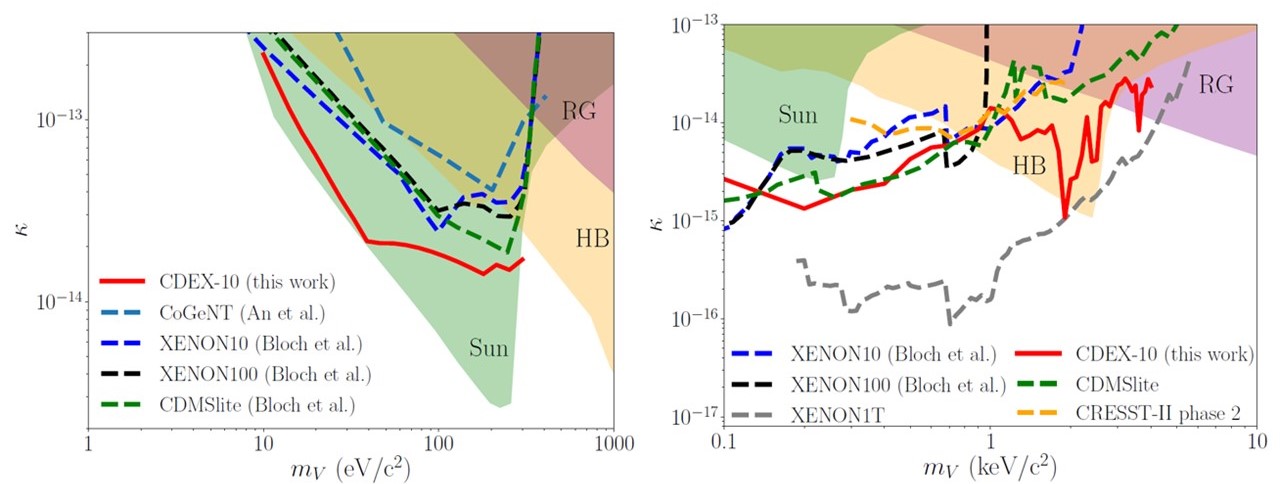CDEX new results of dark photon in PRL reported by Ingrid Fadelli , Phys.org,https://phys.org/news/2020-04-constraints-dark-photons.html
Past cosmological and astrophysical observations suggest that over one quarter of the universe's energy density is made up of a non-conventional type of matter known as dark matter. This type of matter is believed to be composed of particles that do not absorb, emit or reflect light, and thus cannot be observed directly using conventional detection methods.
Researchers worldwide have carried out studies aimed at detecting dark matter in the universe, yet so far, none of them has been successful. Even the preferred candidate for dark matter, weakly interacting massive particles (WIMPs), have not yet been observed experimentally.
The China Dark Matter Experiment (CDEX) collaboration, a large team of researchers at Tsinghua University and other universities in China, has recently conducted a search for a different possible dark matter candidate known as the dark photon. While the search was unsuccessful, their paper, published in Physical Review Letters, identifies new constraints on a dark photon parameter that could inform future studies.
"The dark photon, a hypothetical invisible particle, is an attractive dark matter candidate, which could also be a new interaction mediator between dark matter and normal matter," Qian Yue, one of the researchers who carried out the study, told Phys.org. "The study and detection of dark matter may contribute to the extension of the standard model (SM) of particle physics and expand our knowledge of the universe."
The CDEX collaboration has been conducting searches for light dark matter for some time now, using a 10 kg p-type point contact germanium detector installed at the China Jinping underground laboratory (CJPL). CJPL is the deepest underground research facility in the world, with a rock overburden of 2400 meters.
The detector used by the researchers consists of three triple-element germanium detector strings, surrounded by 20-cm-thick, high-purity, oxygen-free copper, which acts as a passive shield against ambient radioactivity. This instrument is directly immersed in liquid nitrogen to maintain relatively cool temperatures.
"Dark photons can be experimentally detected through their absorption and conversion to electrons in the germanium detectors in a process analogous to the photoelectric effect of SM photons," Yue explained. "Intense photon sources, e.g., the sun, provide an excellent platform to look for dark photons. At a range of 100 eV, the low energy threshold of point-contact germanium detectors is particularly suitable for the studies of dark photons."In their recent paper, Yue and his colleagues analyzed data collected using the detector at CJPL between February 2017 and August 2018, searching for solar dark photons and dark photons, two dark matter candidates. While the researchers were unable to observe signals pointing to either of these candidates, they managed to set constraints on the effective kinetic mixing parameter between dark photons and SM photons.

Fig 1. The exclusive limits of solar dark photons (Left) and dark photon dark mtter (Right)
"As an attractive candidate for dark matter and a new possible interaction mediator between dark matter and normal matter, the dark photon is attractive for further theoretical and experimental efforts," Yue said. "Our work has probed a new parameter space and set the most stringent limits on solar dark photons among the direct detection experiments."
The recent study carried out by Yue and his colleagues provides some valuable new feedback that could inform future searches for dark matter, particularly for dark photons. Moreover, their work reinforces the current worldwide interest in exploring other dark matter candidates, going beyond WIMPs and their detection channel of elastic scattering with the nucleus.
"To further advance the search for light dark matter, we will re-install the CDEX-10 detector array in a new, larger liquid nitrogen cryo-tank with a volume of about 1700 m3 at Hall-C of the new CJPL-II laboratory in next two years, where shielding from ambient radioactivity is provided by the 6-meter-thick liquid nitrogen," Yue said. "Additional germanium detectors, up to about 100 kg, are planned for deployment in the cryo-tank with reduced background and higher detection efficiency."